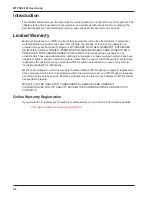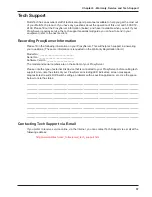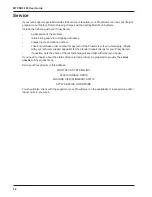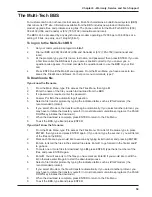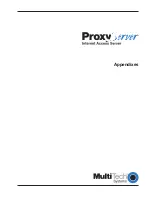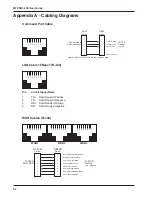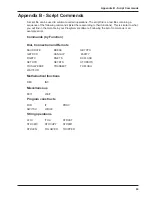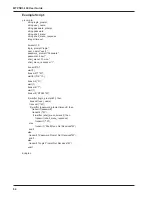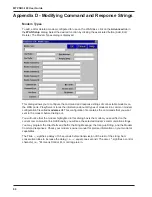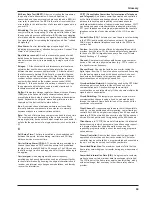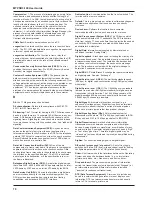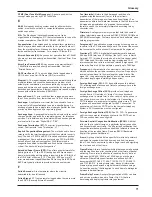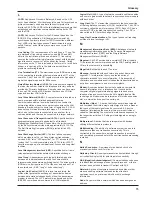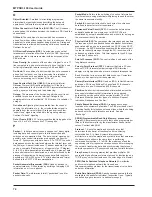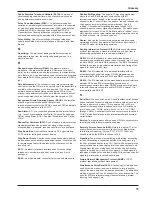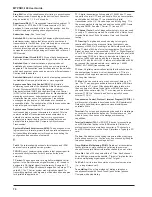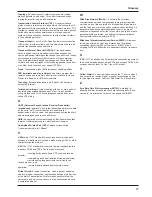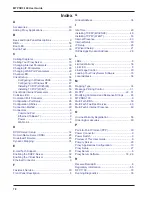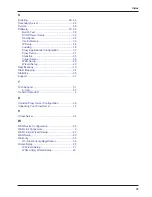
70
MTPSR3-100 User Guide
Compression: 1. The process of eliminating gaps, empty fields,
redundancies, and unnecessary data to shorten the length of
records or blocks. 2. In SNA, the replacement of a string of up to
64-repeated characters by an encoded control byte to reduce the
length of the data stream to the LU-LU session partner. The
encoded control byte is followed by the character that was
repeated (unless that character is the prime compression
character). 3. In Data Facility Hierarchical Storage Manager, the
process of moving data instead of allocated space during
migration and recall in order to release unused space. 4.
Contrast with decompression.
COMx Port: A serial communications port on a PC.
congestion: A network condition where there is too much data
traffic. The ITU I.233 standard defines congestion managemennt
in terms of speed and burstiness.
congestion notification: The function in frame relay that
ensures that user data transmitted at a rate higher than the CIR
are allowed to slow down to the rate of the available network
bandwidth.
Consecutive Severely Errored Seconds (CSES): An error
condition that occurs when from 3 to 9 SES (Severely Errored
Seconds) are logged consecutively.
Customer Premise Equipment (CPE): The generic term for
data comm and/or terminal equipment that resides at the user
site and is owned by the user with the following exclusions: Over
voltage protection equipment, inside wiring, coin operated or pay
telephones, “company-official” equipment, mobile telephone
equipment, “911” equipment, equipment necessary for the
provision of communications for national defense, or multiplexing
equipment used to deliver multiple channels to the customer.
D
D4: the T1 4th generation channel bank.
D4 channelization: Refers to the compliance with AT&T TR
62411 for DS1 frame layout.
D4 framing: The T1 format for framing in AT&T D-Series channel
banks, in which there are 12 separate 193-bit frames in a super-
frame. A D4 framing bit is used to identify the channel and the
signaling frame. Signalling for voice channels is carried in-band
for every channel, along with the encoded voice. See “robbed-bit
signaling”.
Data Communications Equipment (DCE): Any device which
serves as the portal of entry from the user equipment to a
telecommunications facility. A modem is a DCE for the telephone
network (PSTN) that is commonly on site at the user’s premises.
Packet Switched Networks have another level of DCE which is
most often located at a central office.
Data Link Connection Identifier (DLCI): One of the six
components of a frame relay frame. Its purpose is to distinguish
separate virtual circuits across each access connection. Data
coming into a frame relay node is thus allowed to be sent across
the interface to the specified “address”. The DLCI is confirmed
and relayed to its destination, or if the specification is in error,
the frame is discarded.
Dataphone Digital Service (DDS): A private line digital service
that offers 2400, 4800, 9600 and 56K bps data rates on an inter-
LATA basis by AT&T and on an intra-LATA basis by the BOCs.
Data Service Unit (DSU): A device that provides a digital data
service interface directly to the data terminal equipment. The
DSU provides loop equalization, remote and local testing
capabilities, and a standard EIA/CCITT interface.
Dedicated Line: A communication line that is not switched. The
term leased line is more common.
Default: This is a preset value or option in software packages, or
in hardware configuration, that is used unless you specify
otherwise.
Device driver: Software that controls how a computer
communicates with a device, such as a printer or mouse.
Digital Cross-connect System (DCS): The CO device which
splits and redistributes the T1 bandwidth. The DCS takes time
slots from various T1 lines and alters them to provide the needed
connectivity. DCS connections are made with software at an
administrator’s workstation.
Digital Data: Information represented by discrete values or
conditions (contrast “Analog Data”).
Digital Loopback: A technique used for testing the circuitry of a
communications device. Can be initiated locally, or remotely (via
a telecommunications device). The tested device decodes and
encodes a received test message, then echoes the message
back. The results are compared with the original message to
determine if corruption occurred en route.
Digital PBX: A Private Branch Exchange that operates internally
on digital signals. See also “Exchange”.
Digital Service, level 0 (DS0): The worldwide standard speed
(64K bps) for digital voice conversation using PCM (pulse coded
modulation).
Digital Service, level 1 (DS1): The 1.544M bps voice standard
(derived from an older Bell System standard) for digitized voice
transmission in North America. The 1.544M bps consists of 24
digitally-encoded 64K bps voice channels (north America) and
2.048M bps (30 channels) elsewhere.
Digital Signal: A discrete or discontinuous signal (e.g., a
sequence of voltage pulses). Digital devices, such as terminals
and computers, transmit data as a series of electrical pulses
which have discrete jumps rather than gradual changes.
Digital Signaling Rates (DSn): A hierarchical system for
transmission rates, where “DS0” is 64K bps (equivalent to ISDN
B channel), and DS1 is 1.5 Mbps (equivalent to ISDN PRI).
Digital Transmission: A method of electronic information
transmission common between computers and other digital
devices. Analog signals are waveforms: a combination of many
possible voltages. A computer’s digital signal may be only “high”
or “low” at any given time. Therefore, digital signals may be
“cleaned up” (noise and distortion removed) and amplified during
transmission.
Digitize: To convert an analog signal to a digital signal.
DIP switch (pronounced “dip switch”): A set of tiny toggle
switches, built into a DIP (dual in-line package), used for setting
configurable parameters on a PCB (printed circuit board).
Driver: A software module that interfaces between the Operating
System and a specific hardware device (e.g., color monitors,
printers, hard disks, etc.). Also known as a device driver.
Drop and Insert: The process where a portion of information
carried in a transmission system is demodulated (“Dropped”) at
an intermediate point and different information is included
(“Inserted”) for subsequent transmission.
DTE (Data Terminal Equipment): A term used to include any
device in a network which generates, stores or displays user
information. DTE is a telecommunications term which usually
refers to PCs, terminals, printers, etc.
Содержание ProxyServer MTPSR3-100
Страница 1: ...Internet Access for LAN Based Users Model MTPSR3 100 User Guide ...
Страница 5: ...Chapter 1 Introduction and Description ...
Страница 13: ...Chapter 2 Installation ...
Страница 16: ...16 MTPSR3 100 User Guide ...
Страница 17: ...Chapter 3 Software Loading and Configuration ...
Страница 24: ...24 MTPSR3 100 User Guide ...
Страница 25: ...Chapter 4 ProxyServer Software ...
Страница 37: ...Chapter 5 Client Setup ...
Страница 54: ...54 MTPSR3 100 User Guide ...
Страница 55: ...Chapter 6 Warranty Service and Tech Support ...
Страница 61: ...Appendixes ...
Страница 67: ...Glossary of Terms ...

